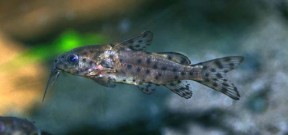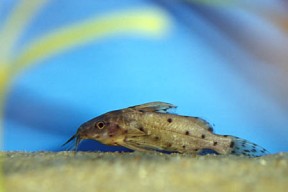Synodontis nigrita
False Upside-down Catfish
Classification
Mochokidae
Distribution
A widespread species that has been recorded in Egypt, Nigeria, Mali, Senegal, Guinea Bissau, Ghana, Cameroon, Sudan, Niger, Chad and Gambia.
Habitat
It usually inhabits backwaters and small pools and ponds.
Maximum Standard Length
7″ (17.5cm)
Aquarium SizeTop ↑
36″ x 12″ x 12″ (90cm x 30cm x 30cm) – 80 litres.
Maintenance
A dimly lit aquarium with a soft substrate and rocks, pieces of driftwood and twisted roots arranged to form hiding places suits this species. Floating vegetation is also recommended in order to diffuse the light entering the tank. Other planting is beneficial but not essential.
Water Conditions
Temperature: 70-82°F (21-28°C)
pH: 6.0-7.8
Hardness: 3-20° H
Diet
Synodontis are omnivorous and are most unfussy in terms of feeding. Frozen, live and dried foods are all accepted. It also relishes vegetable matter in the form of shelled peas, cucumber etc., which it will rasp at with the teeth in its lower jaw.
Behaviour and CompatibilityTop ↑
Should not be kept with any fish so small as to be considered food. Ideal tankmates include Alestiid tetras, robust cichlids (particularly West African species), Mormyrids, Knifefish, Gouramis and larger rasboras and barbs. It tends to become slightly territorial as it matures, especially towards other Synos. However any aggression is usually far less pronounced than in some other members of the genus and it can be maintained in a small group in a suitably sized aquarium, provided each fish is given a refuge to call home. Not recommended for the general community due to its adult size.
Sexual Dimorphism
The female is plumper than the male when adult. It can also be sexed by examining the genital papillae. This is not for the amateur however. The fish should be held ventral side up in the palm of your hand. The dorsal fin should be taken between your middle and ring fingers in order to avoid being pierced by the sharp dorsal fin rays. The genital area you are looking for is concealed beneath the pelvic fins. This can be exposed by pulling (gently) on the caudal fin. A male fish will exhibit an extended papillae which should be pointed and ridged. The spermatoduct can be seen on the caudal side. Females also have a clearly visible papillae but this is more rounded and the oviduct is on the opposite side to the male’s spermatoduct.
Most species of medium/large Synodontis can be sexed using this method but it should be noted that most species take 2 years or more to reach sexual maturity.
Reproduction
Unsure. It definitely is being bred bred in captivity but it is unclear as to whether this is by natural methods or on fish farms via the use of hormone injections. In nature S. nigrita breeds in areas of seasonal flooding that are rich in micro-organisms. They are egg scatterers and exhibit no parental care.
NotesTop ↑
This is one of the most common Synos seen in dealers’ tanks and is often incorrectly labelled “Upside-down catfish”. The true upside-down catfish is S. nigriventris and S. nigrita inverts far less frequently than that species although it does often rest in this position. Moreover, S. nigrita grows far larger than S. nigriventris and it is a common sight to see several adult specimens in shops that have been returned by unsuspecting owners.
S. nigrita is often confused with the similar but smaller S. robbianus. They can be distinguished by the greyish base colour of this species as opposed to the browner patterning exhibited by S. robbianus. It is also similar to several other Syno species, especially when juvenile.




